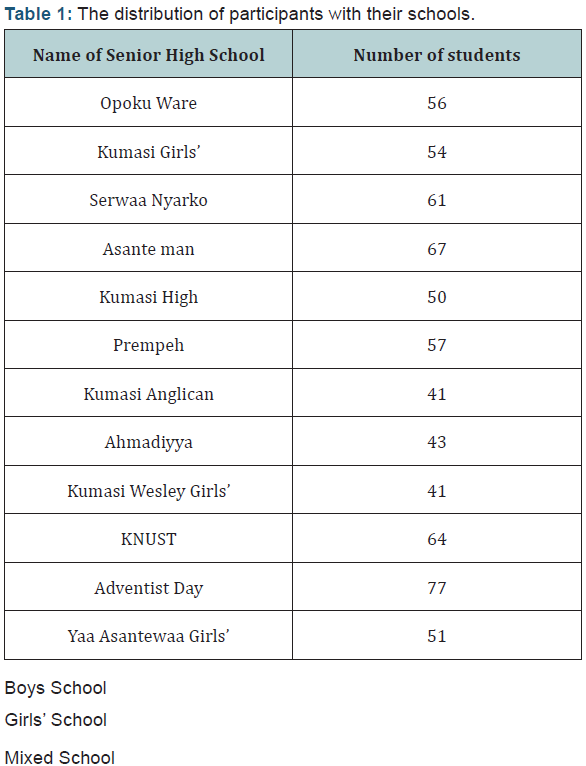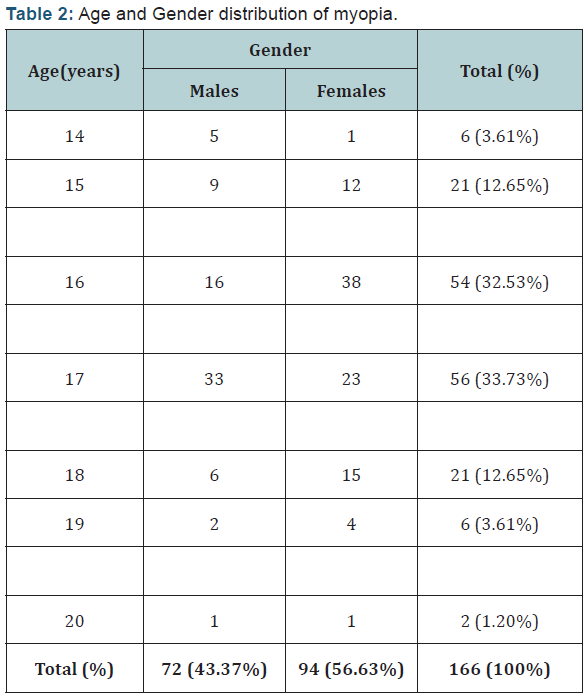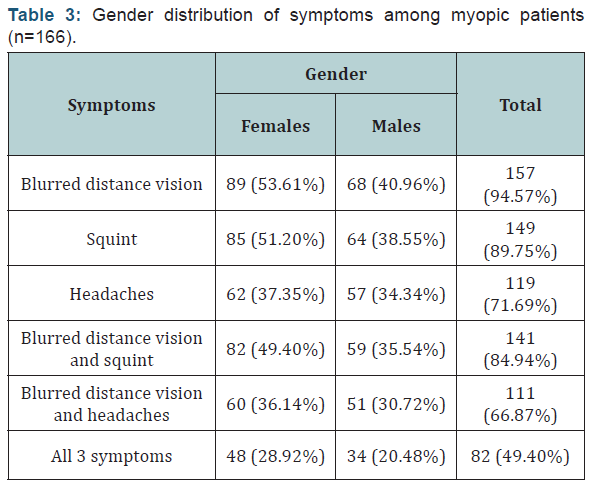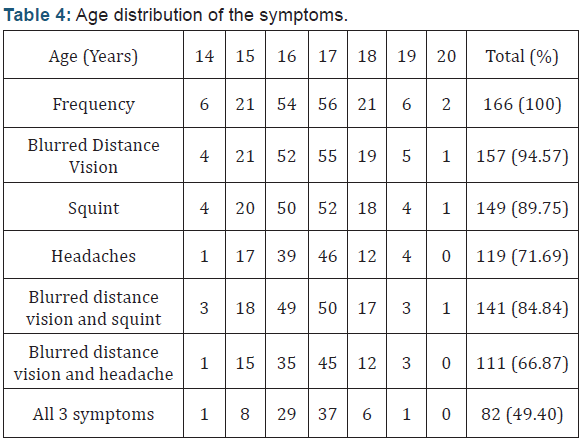Prevalence of Myopia among Senior High School Students in the Kumasi Metropolis-Juniper Publishers
Abstract
The study aimed at determining the prevalence of
myopia, the age and gender distribution of myopia, and the number of
students who show symptoms of myopia in Senior High School students in
the Kumasi metropolis.
Method: A total of 662 students
aged 14-20 years were randomly screened from12 different Senior High
schools in this descriptive cross-sectional study. Data were collected
through interviewer - administered questionnaires, ophthalmic
examination and refraction. Myopia was defined as the best vision sphere
≥-0.25DS.
Results: The study revealed a
myopia prevalence of 25.08% (14.20%infemales) and a mean myopia of
-2.72±0.21DS (-2.84±0.18DS for females) among these students. Majority
of the myopic cases (66.26%) were found in ages 16 and 17. Myopia was
positively correlated with blurred distance vision (r=0.504, p<0.05).
Conclusion: The study revealed
significant prevalence of myopia which may continually increase if
adequate intervention measures are not put in place.
Keywords: Myopia; Prevalence; Squint; Vision; ErrorIntroduction
Myopia is a form of ametropia or refractive error in
which parallel light rays from an object at optical infinity are focused
by the refractive media of the eye to a focus in front of the retina,
with accommodation fully relaxed [1]. Myopes have blurred distance
vision but the object becomes clearer as it gets closer. Myopes squint
(thus slightly close their eye so reduce palpebral aperture) for
distance object in order to create a pinhole effect there by reducing
spherical aberrations to create clearer image. Some common symptoms
include: blurred distant vision, squinting, nausea and fatigue. Patients
with myopia are more at risk of developing retinal detachment, primary
open angle glaucoma, chorioretinal atrophy, lacquer cracks, (sub
capsular, cortical and nuclear) cataract and myopic macular degeneration
than patients with hyperopia [2-8] cause and therefore may be
considered to be a multi factorial in origin [9]. Among many risk
factors associated with myopia, doing a substantial amount of near work
on a regular basis also increase the risk for myopia. Myopia is
associated with greater times pen treading and doing near work, more
years of education, better reading test scores, occupations that require
a great deal of near work and greater academic ability [10-13]. The
problem of myopia is often discovered in school-age children who report
having trouble
seeing the chalkboard. Myopia becomes progressively
worse through adolescence and stabilizes in early adulthood. In fants
are mostly born hyperopic and they become less so with the approach
towards ametropia [9]. It has been reported that the prevalence of
myopia is heightening in both developed and developing countries
[14,15]. In school-age and young adult, the prevalence of myopia is
estimated to be 20-25% in the mid to late teen age population and 25-35%
in young adults in the United States and developed countries [16,17].
In developed countries, screening of eyes in school children is done
routinely. Eye services are easily accessible, and the majority of
children with eye problems consult them without requiring referral by
other health professionals [18]. In Ghana like other developing
countries, there is no established vision screening program for students
on commencement of school, such that those with early onset of such
errors will have many years of poor vision. Moreover, it is often
difficult to provide an efficient refraction service for a variety of
reasons including lack of awareness about the prevalence and public
health importance of eye diseases and most importantly recognition of
refractive error as a correctable cause of visual impairment in
students, compounded by the non-availability of affordable services. The
proportion of children who are blind or visually impaired due to
refractive errors (with myopia being the
most prevalent) can be used to assess the level of development of
eye care services in a country [19-21].
Despite the fact that myopia is such serious problem, only
a few papers have been published so far on the prevalence of
myopia among school children in Ghana [22-24] as well as hospital
based research [25-27]. All these publications report significant
prevalence of hyperopia and show a growing need to tackle this
problem. The study aimed at determining the prevalence of
myopia, the number of students who show symptoms of myopia
and the age and gender distribution of myopia in Senior High
School students with in the Kumasi metropolis.
Methods
Study design and participant selection
A descriptive cross-sectional study was adopted in for this
population survey to determine the prevalence of myopia in
Senior High school students in the Kumasi metropolis. Twelve
(12) Senior High schools (5 mixed schools, 3boys’ schools and
4girls ’schools) were randomly selected among all Senior High
Schools in the Kumasi metropolis. A total of 662 study subjects,
out of the 731 students who returned their signed informed
consents, were present on the days of screening and participated
in the study. The students and principals of these selected Senior
High schools were contacted and informed consent obtained after
a detailed explanation of the purpose, content and benefit of the
study. The information exchanged between the respondents and
there searcher was confidential and were kept as such. Ethical
approval was obtained from the Ethics Review Board of the
Department of Optometry and Visual Science, Kwame Nkrumah
University of Science and Technology, and the study complied
with the principles of the Declaration of Helsinki.
Pre-survey stage/pilot project
In a bid to test the adequacy of their search instruments,
a pilot study was organized at Kwame Nkrumah University of
Science and Technology (KNUST) Senior High School.
Data collection technique
Data were collected by optometry students who were killed
in measuring all the parameters of interest while the principal
investigator ensured that the testing protocol was adhered to.
Prior to the ophthalmic examination, a questionnaire(for patient
history) was given to the students to capture demographic
information (age, sex, address and telephone number) and also
together information about their chief complaint, visual function,
date of last eye examination, knowledge of refractive status,
spectacle wear, ocular and systemic health as well as the life style
of the student. A thorough ophthalmic examination/eye screening
was carried out in all the students randomly selected in the
selected schools. The screening procedure included the following:
Visual acuity measurement, Ophthalmoscopy and subjective
refraction. In this study, myopia was defined as the best vision sphere power of ≥-0.25 DS.
Data analysis
The data was analyzed using the Statistical Package for Social
Sciences (SPSS Inc., Chicago, Illinois, USA) version 12.0 and
Microsoft Excel 2007 (Microsoft, Redmond, Washington, USA)
after the data collected had been checked for completeness of
answers and accuracy. Associations in the categorical variables
were determined using Chi-Square test. Paired t-test was used
to assess the difference in myopia between males and females in
the study. Pearson correlation was used to assess the relationship
between myopia and the reported symptoms. P-value less than
0.05 were considered significant.
Results
Demographics of the study population

In all, 662 out of the 731 students who submitted their
informed consents were screened. The mean age for the study
population was 16.16±2.60 years (age range =14 to 20 years,
with 376(56.8%) being males). A breakdown of the distribution
of the participants with their schools and gender distribution of
participants are shown in (Table 1). From this point onwards,
results belonging to the myopic population alone were reported.
Out of the 662 respondents, 166 had myopia representing a
prevalence of 25.08%. 72 (43.37%) of the myopic population were
males. The mean myopia found in this study was -2.72±0.21DS (with a range from-0.25DS to -6.00DS). The mean myopia in
the male and female myopic groups was -2.60±0.24DS and
-2.84±0.18DS. The difference in mean myopia between the male
and female groups was not significant (p=0.67). Majority of the
myopic cases (66.26%) was found in the ages of 16 and17 years.
(Table 2) shows the distribution of myopia by age and gender.
(Table 3) shows the distribution of symptoms by gender within
the myopic subgroup of the study population. The most frequent
symptom was blurred distance vision (n=157, 94.57%). (Table 4)
shows the age distribution of certain symptoms recorded from
the respondents. The highest frequency of myopic symptoms was
recorded for students aged 16 and 17 years.



Discussion
The prevalence of myopia in this study (25.08%) was low
compared to 55.7%, 83%, 42% and 68% reported by El-Bayoumey
et al. In Cairo, Chenetal. In Taiwan, Goh & Lamin Hong Kong,
and Fangrunetal. In Shanghai. [20,28-30]. This confirms studies
which have indicated that myopia is more prevalent in Asians
than Africans. This high prevalence of myopia among Asians has
been attributed to the intensive educational systems that demand
more near work from Asian school children [31-33]. Other
similar studies in Ghana compared to this study reported lower
prevalence of myopia. This could probably be due to the definition
of myopia in those studies (≥-0.50DS compared to ≥-0.25DS in
the current study) and the different populations studied [22-24].
On the other hand, the prevalence of myopia in this study was
higher than that among secondary school students in Mwanzacity,
Tanzania which reported a prevalence of 5.6% [34]. Studies have
found equivocal results regarding the difference in the prevalence
of myopia among males and females [9,22,27,35,36]. In this study,
there was no significant difference in the prevalence of myopia
between the males and females (p>0.05).The mean myopia in
females was slightly higher than that of the males. However, the
difference in mean myopia between the male and female groups
was not significant (p=0.67). Kumah reported a lower percentage
of myopia among boys in Atwima the Ashanti region of Ghana
[22]. Reasons given to account for this were that, females grow
rapidly than males and also tend to read and write more than males. The subsequent increase in near work predisposes them to
myopia development as seen in you then set myopia [9]. Koomson
et al. [27] reported a higher prevalence estimate in males than in
females. There reason given was that, sex-related difference of
myopia is not certain but could be due to the relative differences
in response to health seeking behavior. Also, it could be that males
do more jobs requiring corrected myopia than females.
A total of 94.57% of the myopic respondents complained of
blurred distance vision while 71.69% complained of headaches.
The difference in symptoms reported between the males and
females was not significant for each of the symptom category (p>0.05). Pearson’s correlation revealed a positive significant
association between myopia and blurred distance vision (r=0.504,
p<0.05). There was no correlation between myopia and all the
other symptom categories (p>0.05). The complaint of headache
is not usually associated with true myopic patients with the
exception of pseudomyopia and some forms of induced myopia.
If as asthenopia is present in a patient with myopia, it is usually
due to some other cause, such as astigmatism, anisometropia,
an accommodative dysfunction, or a vergence disorder, thus
headache is not pathognomonic of pure myopia [37]. There was a
significant difference of myopia occurrence among the age groups,
similar to what was reported by Kumah in 2007 (p<0.05) [22]. In
this study, the students between the 15 to18 year brackets had
the highest prevalence of myopia (91.56%), of which 32.53% and
33.73% were 16 and 17 years respectively. This was so because
the majority of the respondents were16and17 years, which was
comparable to other studies. Apart from myopia being inherited,
students tend to do more extensive near work like reading
textbooks, watching TV, playing video games, browsing the net,
among others, due to the socio economic growth and changes. This
has contributed to the increase in the prevalence in these ages.
Most of respondents (80%) were not aware of their refractive
status. This was probably due to the fact that most of them had not taken an eye examination before, a common occurrence among
developing countries [38]. This is similar to low proportions of
students who have had eye examinations before in several studies
conducted in most developing countries in Africa [23,24,28,34,39].
For the few who had spectacle corrections (2%), most of them
were reluctant in using their corrections for they wanted to be
accepted by their peers and also for some perceived probable side
effects associated with lens wear. For instance, some people don’t
appreciate their appearanceing lasses and they think it detracts
from their facial aesthetics or hides their features [40].
Conclusion
This study has revealed a significant prevalence of myopia
among senior high school students in the Kumasi metropolis. It is
likely that both the rate and severity of myopia will increase as a
result of the rapid socio economic growth of Kumasi and Ghana as
a whole, if the needed efforts are not taken to put its progression
under control. Myopia is considered as one of the important
medical, social and public health issues that need to be addressed
in Kumasi and other regions in Ghana. Were commend that a
policy be put up by the Ghana Education Service which will allow
the inclusion of pre-school and a routine in-school eye screening
for all levels of education. Through the school health education
programmers of the Ghana education service, students, teachers
and the communities should be educated on the importance of
ocular health. They should be trained to identify the different
refractive states of the eye, especially myopia; its signs, symptoms
and complications so that they can report to the appropriate
quarters for the appropriate assessment and management.
Acknowledgement
We would like to acknowledge the principals of the selected
Senior High School in the Kumasi Metropolis for their support in
providing venues during the time of the study.
For more articles in JOJ Ophthalmology (JOJO) please click on: https://juniperpublishers.com/jojo/index.php
No comments:
Post a Comment